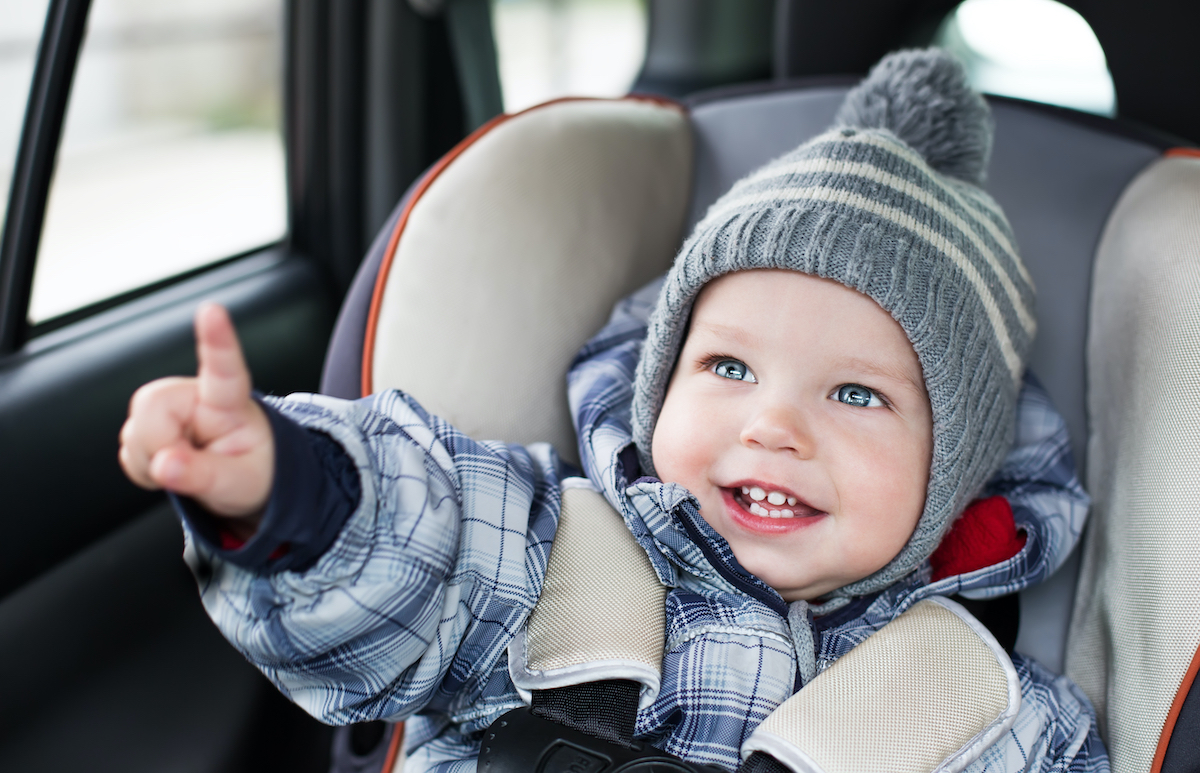Here in Western New York, we don’t let a little cold weather stand in our way. Skiing, sledding, enjoying a nature walk – that’s what we do. Bundle the kids up, pack a thermos of hot chocolate, and you’re on your way. But before you head out, take a quick check of your child’s car seat.
As a general rule, bulky clothing, including winter coats and snowsuits, should not be worn underneath the harness of a car seat. Thick winter coats can keep your baby warm but they can compromise your child’s car seat safety.
In order for car seats and boosters to function properly, the straps need to remain tight against your child’s chest. Winter coats and snowsuits change the way a child fits into the car seat. In a car crash, the fluffy padding immediately flattens out from the force, leaving extra space under the harness. A child can then slip through the straps and be thrown from the seat.
Here’s a simple way to check whether your child’s coat is too big to wear underneath a harness:
Step 1: Put the coat on your child, sit him or her in the car seat and fasten the harness. Tighten the harness until you can no longer pinch any of the webbing with your thumb and forefinger.
Step 2: Without loosening the harness at all, unhook it and remove your child from the car seat. Take the coat off, put your child back in the car seat, and buckle the harness straps, which should be adjusted just as they were when the child was wearing the coat.
If you can pinch the webbing between your thumb and forefinger now, then the coat is too bulky to be worn under the harness.
How to Keep Your Child Warm and Safe in the Car Seat
These tips from the American Academy of Pediatrics (AAP) will help parents strike that perfect balance between keeping little ones warm as well as safely buckled in their car seats.
* Get an early start. If you’re planning to head out the door with your baby in tow on winter mornings, you need an early start. You have a lot to assemble, and your baby may not be the most cooperative. Plus, driving in wintry conditions will require you to slow down and be extra cautious.
* Store the carrier portion of infant seats inside the house so it isn’t cold when you put your child into it. Keeping the seat at room temperature will reduce the loss of the child’s body heat in the car.
* Warm up your vehicle before you go.
* Dress your baby or toddler in thin layers of clothing . Each layer holds warm air. The layer next to the skin should be close-fitting, such as tights, leggings, long underwear, or a long-sleeved bodysuit. Then add pants and a warmer top, like a sweater or thermal-knit shirt. Your child can wear a thin fleece jacket over the top. In very cold weather, long underwear is also a warm and safe layering option. As a general rule of thumb, infants should wear one more layer than adults.
* Add a hat, mittens, and warm socks or booties to keep head, hands, and feet toasty. These help keep kids warm without interfering with car seat straps.
* Buckle the seat, adjusting the straps each time you do. You should only be able to get one finger under the harness at your child’s collarbone. If you can pinch the strap, it is too loose.
* Use a coat or blanket over the straps,. You can add a blanket over the top of the harness straps or put your child’s winter coat on backwards (over the buckled harness straps) after he or she is buckled up. As the car heats up, you can remove a blanket so your child doesn’t overheat.
* Use a car seat cover ONLY if it does not have a layer under the baby. Nothing should ever go underneath your child’s body or between her body and the harness straps. Be sure to leave baby’s face uncovered to avoid trapped air and re-breathing.
* Pack an emergency bag for your car. Keep extra blankets, dry clothing, hats and gloves, and non-perishable snacks in your car in case of an on-road emergency or your child gets wet on a winter outing.
Have a great time enjoying the great WNY outdoors this winter! Follow the tips above and your family will be happy … and safe!
